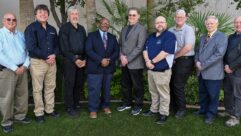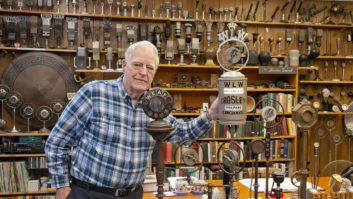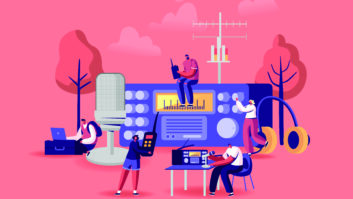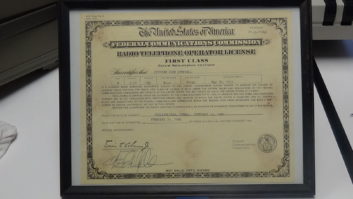Hams Doing Public Service? Please.
The following is in response to Radio World coverage of the Hamvention (“Amateur Event Continues to Pack ’Em In,” Aug. 1) and Dan Thomas’s enthusiastic letter to the editor (“Kahn Helped Young Engineers,” Sept. 26).
I am an extra class ham operator with 52 years on the air. While a very small percentage of hams are like what Dan says, the vast majority do nothing for public service or little to advance the state of the art.
The day of hams being an asset has long ago disappeared except for some rare instances. Hams are appliance operators and sit in their shacks and cackle endlessly about minutia. They run “contests” where they lie about signal reports and pass useless data.
The tests are laughable: My daughter passed her exam for the “Tech Plus” when she was eight years old, so how hard could it be? All the questions and answers are published.
The only skill that was required was Morse Code, and that has been eliminated.
Add to this they put up antennas that blight the neighborhood in the name of something they rarely do — public service. This “right of blight” is protected by the FCC (PRB-1 decision).
As a teacher, I could not even give away thousands of dollars of donated ham equipment because I merely required the students to use it on the air for 100 contacts or more.
If you doubt me, listen on the air, and if you can stand it for more than 30 minutes and are not dead asleep, you are a better person than most.
Burt Fisher K1OIK
Chief Engineer
WCCT(FM)
Sandwich, Mass.
Speaker Wire
I read the article about speaker cables (“You’ll Get Caught Up in This Cable,” Sept. 12) with a knowing grin. Barbed wire, classic!
For almost 20 years, I, too, have heard those who “know” high-end audio insist that there is a huge difference, and that cable must be oxygen-free, twisted, gold-plated, braided and so on. And as an installer of high-end audio/video, I even sold a bunch of the pricey cable.
But the truth is, if it will carry the signal, it will work; 18 AWG lamp cord sounds the same as any high-end cable when listened to with human ears. When working on the TIA-570 standard for residential audio cabling, all I required was that the cable be fire-rated for the application and recommended a minimum of 16 AWG.
If you need a signal generator and an o-scope to show the value of your wire, then you don’t have a leg to stand on. Listeners who spend a tiny amount of money on decent-quality sturdy speaker wire, and the rest on room treatments or better hardware, get a much higher return on their investment.
John L. Seger, RCDD
Owner
ConnectionBridge LLC
Brier, Wash.
Commercial Radio Gets a Bad Rap
I feel compelled to respond to Pete Simon’s “commentary” (“CPB Should Boost Small Stations,” Oct. 10).
Someone complaining throughout an entire article about my and other commercial radio interests, and about tax money not being spent on public radio stations the way he wants it to be, is at the very least disconcerting.
We — commercial radio interests — do not have someone handing us tax money every year to stay in business. We have to work for it.
I have friends in the public broadcasting engineering community and have no animosity towards them. They have been hired to do a job and they are doing it. My animosity is towards the attitude that “this type of programming is not available in the commercial sector. We want it and cannot make it commercially viable, so we have to make everyone pay federal taxes to support it.”
If an individual state wants to set this type of system up, with the blessing of the voters, that is just fine and bless them in the effort. Just do not compel the entire country to subsidize a segment of broadcasting that is in competition with unsubsidized, taxpaying broadcasters.
The entitlement attitude of this “commentary” disgusts me. This article would have been better left in-house in the public broadcasting community, but I am glad that Radio World published it so that everyone could see this type of mindset at work.
Rod Zeigler
Director of Engineering
Nebraska Rural Radio Association
KRVN(AM), KTIC(AM/FM), KNEB(AM)
Lexington, Neb.
O, HD Where Art Thou?
The one thing that immediately hits home about digital radio is how few HD Radio receivers are available. The ones that are available are rather pricey and not really portable. (I have yet to see a HD radio in a car.) However, if you want a radio that does Internet radio, iPod or the like, the field is wide open, with all manner of price.
Now, granted, there is very little HD Radio in the wilds of Idaho; but one would think that someone would offer such a beast. Even online, the pickings are slim and carry a really hefty price tag. Stores like Best Buy and Wal-Mart say they have HD Radios. Not in my neighborhood.
I do work for a public radio network, and they run HD, but they are talking about turning it off, as there is only a handful of people using it. There just doesn’t seem to be any interest in what is being offered.
I have read some interesting comments regarding HD Radio, especially since the passing of Leonard Kahn. There is a real buzz, especially when DRM is brought up, as it applies to AM and shortwave broadcasting.
We must search onward for the answers that will keep radio broadcasting viable and healthy. It can be done.
Mike Payne
Contract Engineer
Townsquare Media
Twin Falls, Idaho











